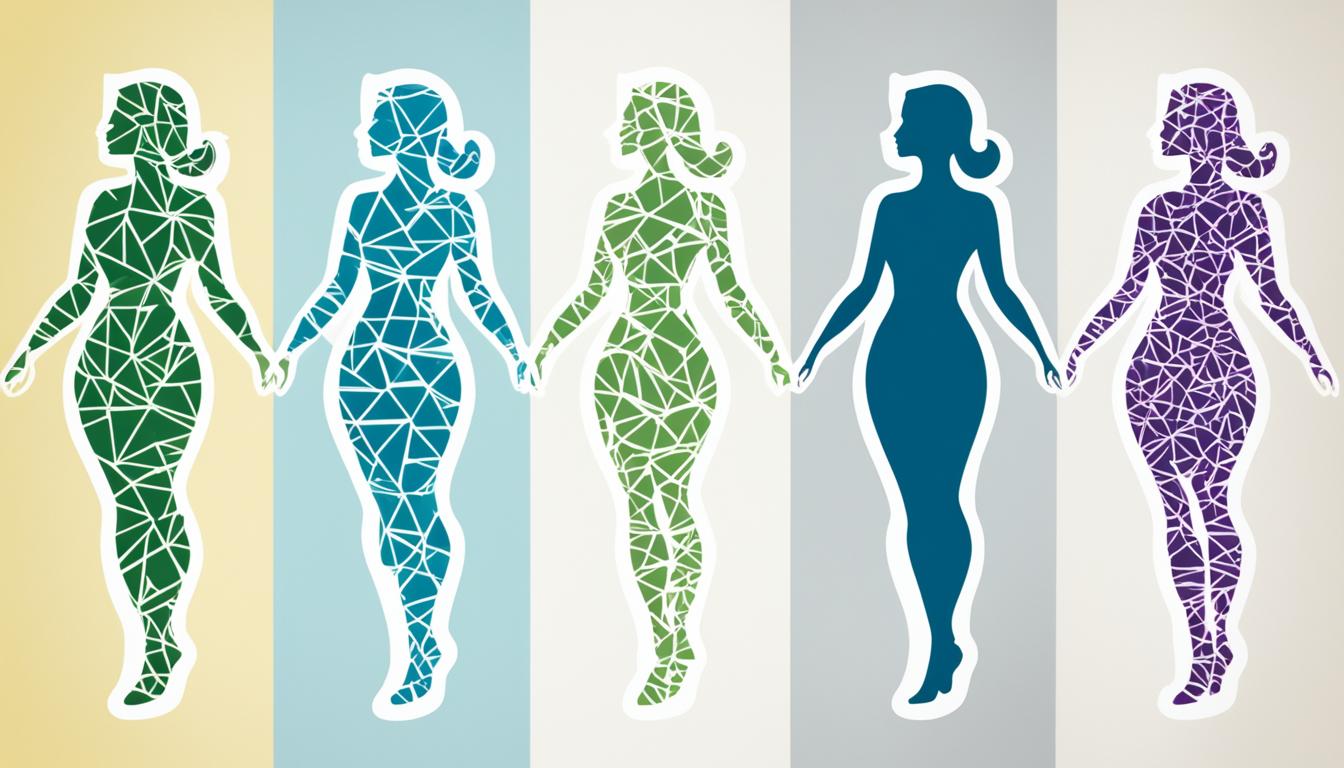Did you know that the Big Five and the Myers-Briggs Type Indicator (MBTI) are two of the most widely used personality frameworks in the world?
When it comes to understanding personality, these two frameworks play a significant role in helping individuals gain insight into themselves and others. While they may seem similar, they have distinct differences in how they categorize and measure personality traits.
In this article, we’ll take a closer look at the Big Five and the MBTI, exploring their strengths, limitations, and how they can be applied in practical ways to enhance personal growth and decision-making processes. Let’s dive in!
Key Takeaways:
- The Big Five and the MBTI are two popular personality frameworks used for understanding individual traits.
- The Big Five measures personality across five dimensions: Openness, Conscientiousness, Extraversion, Agreeableness, and Neuroticism.
- The MBTI categorizes individuals into 16 distinct personality types based on preferences like introversion versus extraversion.
- Both frameworks have their unique strengths and limitations and can be valuable tools for self-reflection and personal development.
- Understanding your personality traits can have practical applications in various aspects of life, including career choices, personal relationships, and decision-making processes.
Understanding the Big Five Personality Model
The Big Five Personality Model is a widely accepted framework that examines human personality through five distinct traits. These traits, namely Openness, Conscientiousness, Extraversion, Agreeableness, and Neuroticism, provide valuable insights into how individuals behave, think, and interact with the world.
Openness: Openness measures a person’s willingness to embrace new experiences and ideas. Individuals who score high in this trait are curious, imaginative, and open-minded, while those with lower scores tend to be more conventional and resistant to change.
Conscientiousness: Conscientiousness explores the level of discipline, organization, and responsibility in individuals. Highly conscientious individuals are diligent, detail-oriented, and reliable, whereas those with lower scores may exhibit traits such as impulsiveness and lack of focus.
Extraversion: Extraversion characterizes the extent to which individuals seek social interaction and gain energy from being around others. Highly extraverted individuals are outgoing, assertive, and enjoy being in the spotlight, while those who score lower prefer solitude and quieter environments.
Agreeableness: Agreeableness measures how individuals show kindness, empathy, and concern for others. People with high agreeableness scores tend to be cooperative, compassionate, and value harmony, whereas those with lower scores may be more competitive and less concerned about others’ well-being.
Neuroticism: Neuroticism examines a person’s emotional stability and their tendency towards anxiety, depression, or mood swings. Individuals with higher neuroticism scores experience more emotional reactivity and may be prone to stress, while those with lower scores exhibit greater emotional resilience.
Understanding the Big Five Personality Model allows us to gain valuable insights into our own behavior, preferences, and interactions with others. By recognizing and acknowledging these traits, we can navigate personal and professional relationships more effectively, make informed decisions, and foster personal growth.

| Trait | Description |
|---|---|
| Openness | Measures openness to new experiences and ideas |
| Conscientiousness | Examines discipline, organization, and responsibility |
| Extraversion | Characterizes social interaction and energy gain from others |
| Agreeableness | Assesses kindness, empathy, and concern for others |
| Neuroticism | Examines emotional stability and reactivity |
Understanding MBTI (Myers-Briggs Type Indicator)
The Myers-Briggs Type Indicator (MBTI) is a widely recognized framework for understanding personality. It is based on the theories of Carl Jung and classifies individuals into 16 distinct personality types. The MBTI focuses on preferences in four key areas: introversion versus extraversion, sensing versus intuition, thinking versus feeling, and judging versus perceiving.
The MBTI provides insights into how individuals perceive the world, make decisions, and interact with others. By understanding these preferences, individuals can gain a deeper understanding of themselves and others, leading to personal growth and improved relationships.
The MBTI is commonly used in personal development and career counseling. It helps individuals identify their strengths, preferences, and potential areas for growth. By leveraging this knowledge, individuals can make informed decisions about their career paths, enhance their communication skills, and develop strategies to manage stress and conflict.

MBTI Personality Types
The MBTI categorizes individuals into 16 different personality types, each represented by a combination of four letters. These types can provide valuable insights into an individual’s preferred ways of thinking, feeling, and behaving. Here are the 16 MBTI personality types:
| Type | Description |
|---|---|
| ISTJ | Introverted, Sensing, Thinking, Judging |
| ISFJ | Introverted, Sensing, Feeling, Judging |
| INFJ | Introverted, Intuitive, Feeling, Judging |
| INTJ | Introverted, Intuitive, Thinking, Judging |
| ISTP | Introverted, Sensing, Thinking, Perceiving |
| ISFP | Introverted, Sensing, Feeling, Perceiving |
| INFP | Introverted, Intuitive, Feeling, Perceiving |
| INTP | Introverted, Intuitive, Thinking, Perceiving |
| ESTP | Extraverted, Sensing, Thinking, Perceiving |
| ESFP | Extraverted, Sensing, Feeling, Perceiving |
| ENFP | Extraverted, Intuitive, Feeling, Perceiving |
| ENTP | Extraverted, Intuitive, Thinking, Perceiving |
| ESTJ | Extraverted, Sensing, Thinking, Judging |
| ESFJ | Extraverted, Sensing, Feeling, Judging |
| ENFJ | Extraverted, Intuitive, Feeling, Judging |
| ENTJ | Extraverted, Intuitive, Thinking, Judging |
Each personality type offers unique strengths, areas of growth, and ways of interacting with the world. Understanding your own MBTI type can provide valuable insights into how you approach work, relationships, and personal development.
Applying MBTI in Personal Development
The MBTI can be a powerful tool for personal development. By understanding your preferences, you can identify areas for growth and develop strategies to enhance your strengths. Here are some ways you can apply MBTI in your personal growth journey:
- Identify your communication style: Understanding your MBTI type can help you understand how you communicate with others and how you can adapt your communication style to be more effective.
- Manage stress and conflict: Recognizing your stress triggers and preferred conflict resolution strategies can help you develop coping mechanisms and improve your ability to navigate challenging situations.
- Set goals aligned with your preferences: By aligning your goals and career choices with your MBTI type, you can find satisfaction and fulfillment in your work.
The MBTI is just one tool in the journey of self-discovery and personal growth. It provides a framework for understanding preferences and can serve as a starting point for deeper exploration. Embrace the insights it offers and use them to enhance your understanding of yourself and others.
Comparing the Big Five and MBTI
While the Big Five and MBTI may seem similar at first glance, they approach personality from different angles. The Big Five assesses personality based on a spectrum within each trait, providing a more fluid and dynamic understanding. On the other hand, the MBTI sorts individuals into one of 16 distinct types, offering a more detailed but static personality profile. Both models have their unique strengths and applications in different contexts.
Similarities and Differences
Although the Big Five and MBTI are distinct personality assessment frameworks, they share some commonalities. Both models aim to categorize individuals based on personality traits and preferences. However, their methodologies and interpretations differ significantly.
- The Big Five: This model emphasizes five major personality dimensions – Openness, Conscientiousness, Extraversion, Agreeableness, and Neuroticism. It measures these traits on a spectrum, allowing for nuanced variations within each dimension.
- The MBTI: Developed from Carl Jung’s theory, the MBTI classifies individuals into 16 specific personality types based on their preferences in four key areas – Extraversion vs. Introversion, Sensing vs. Intuition, Thinking vs. Feeling, and Judging vs. Perceiving. These preferences define one’s type and remain relatively stable.
The following table highlights the key differences between the Big Five and MBTI:
| Framework | Approach | Focus | Flexibility |
|---|---|---|---|
| Big Five | Spectrum-based | Five broad dimensions | Fluid and dynamic |
| MBTI | 16 distinct types | Preferences in four areas | Static and categorical |
As shown in the table, the Big Five offers a more fluid and flexible understanding of personality, while the MBTI provides a more detailed, but fixed, categorization of individuals.
While the Big Five and MBTI take different approaches to personality assessment, they both contribute valuable insights and can be beneficial in various contexts. Whether you prefer the broader spectrum of the Big Five or the specific types of the MBTI, both frameworks offer valuable tools for self-reflection, personal growth, and understanding others.

Understanding the similarities and differences between the Big Five and MBTI can help individuals navigate the complexities of their own personalities and gain insights into the personalities of others. By utilizing the strengths of both frameworks, we can develop a more comprehensive understanding of the multifaceted nature of human personality.
Practical Applications in Everyday Life
Understanding the Big Five traits and MBTI type can have practical applications in various aspects of our everyday lives. These frameworks provide valuable insights into our personalities and can be used for self-improvement and career counseling. By leveraging our intrinsic traits and preferences, we can enhance our decision-making processes, improve personal relationships, and make informed career choices.
Career Counseling
When it comes to career counseling, the Big Five and MBTI can help us understand our strengths, interests, and values, guiding us towards fulfilling career paths. The Big Five’s traits, such as Conscientiousness and Extraversion, can provide insight into which professions may suit us best. For example, individuals high in Conscientiousness might excel in detail-oriented roles, while those high in Extraversion might thrive in jobs that involve frequent social interactions. The MBTI’s personality types offer a different perspective, giving us a deeper understanding of our preferences and work style. By aligning our career choices with our personality traits, we can find greater satisfaction and success in our professional lives.
Self-Improvement
Understanding our personality traits through the Big Five and MBTI can also be a powerful tool for self-improvement. These frameworks provide insight into areas where we may have strengths and areas where we may need to focus on personal growth. For example, if we score low in Agreeableness in the Big Five, we may realize the importance of developing empathy and cooperation skills to enhance our relationships. Similarly, the MBTI can shed light on our natural inclinations, such as whether we tend to rely more on logic or emotions in decision-making. By being aware of our personality traits, we can consciously work on developing areas for improvement and cultivating positive qualities that can lead to personal growth.
Enhancing Relationships
The Big Five and MBTI can also contribute to more fulfilling personal relationships. By understanding our own personality traits and those of others, we can navigate conflicts and communication differences more effectively. For instance, recognizing that someone is high in Neuroticism can help us understand their emotional sensitivity and respond with greater empathy. Similarly, being aware of our own preferences, such as Introversion or Extraversion, can help us communicate our needs to our partner or friends and create a harmonious environment. The Big Five and MBTI provide a shared language to discuss and appreciate our unique qualities, promoting understanding and empathy in our relationships.
“By leveraging our intrinsic traits and preferences, we can enhance our decision-making processes, improve personal relationships, and make informed career choices.”
Overall, the practical applications of the Big Five and MBTI extend beyond theoretical frameworks. They offer practical tools for self-improvement, career counseling, and cultivating deeper connections with others. By utilizing the insights provided by these personality models, we can make more informed decisions, grow as individuals, and lead more fulfilling lives.

Strengths and Limitations
Both the Big Five and MBTI offer valuable insights into personality, but they also have their limitations. The Big Five is widely accepted in the scientific community for its empirical basis and flexibility in traits. It provides a comprehensive framework that allows for a nuanced understanding of personality, making it suitable for a wide range of applications.
“The Big Five provides a comprehensive framework that allows for a nuanced understanding of personality.”
On the other hand, the MBTI has faced criticism for its lack of scientific validity and empirical evidence. Its classification into 16 distinct personality types has been questioned, as well as its ability to predict behavior. The MBTI is often viewed as more of a self-reported assessment tool rather than a scientifically supported measure.
Despite these limitations, both the Big Five and MBTI can be valuable tools for self-reflection and personal development. They offer individuals a starting point for exploring their own strengths and weaknesses, as well as understanding their interaction with others.
Here is a comparison of the strengths and limitations of the Big Five and MBTI:
| Big Five | MBTI |
|---|---|
| Widely accepted in the scientific community | Lack of scientific validity and empirical evidence |
| Flexible framework that allows for a nuanced understanding of personality | Relies on classification into 16 distinct personality types |
| Supported by extensive research and studies | Considered more of a self-reported assessment tool |
| Provides a comprehensive and detailed analysis of individual traits | Simplifies personality into dichotomies, potentially oversimplifying complexity |
It is important to view these models as tools for self-reflection and personal growth, rather than definitive answers to personality. Taking into account their strengths and limitations allows us to make informed interpretations and use them effectively in our journey of self-discovery.

Embarking on a Journey of Self-Discovery
Self-discovery is a lifelong process that allows us to understand ourselves on a deeper level. It is a voyage of personal growth and understanding our unique place in the world. The Big Five and the Myers-Briggs Type Indicator (MBTI) are valuable tools that can aid us in this journey, offering different paths to self-awareness and personal development.
The Big Five provides us with a framework to explore five fundamental dimensions of personality: Openness, Conscientiousness, Extraversion, Agreeableness, and Neuroticism. These traits can help us gain insight into how we think, feel, and behave in different situations. Understanding our Big Five traits can pave the way for personal growth by highlighting areas for improvement and celebrating our strengths.
The MBTI, on the other hand, delves into our preferences and personality types. It offers a map to uncover our natural inclinations, such as whether we lean towards introversion or extraversion, intuition or sensing, thinking or feeling, and judging or perceiving. By understanding our MBTI type, we can gain a better understanding of our preferences and how they shape our interactions with others.
Both the Big Five and MBTI provide valuable insights into our personalities. While the Big Five focuses on traits and the MBTI on preferences, they both contribute to our self-discovery and personal growth. It is important, however, to remember that these models are just pieces of the puzzle. Personality is dynamic and multi-faceted, and no single framework can fully capture its complexity.
To illustrate this, let’s take a look at a comparison table between the Big Five and MBTI:
| Framework | Focus | Number of Dimensions/Types | Measurement |
|---|---|---|---|
| Big Five | Traits | 5 | Score-based scale |
| MBTI | Preferences | 16 | Categorical type |
This table highlights the different aspects of the two frameworks, showcasing their distinct approaches to understanding personality. While the Big Five focuses on measuring traits through a score-based scale, the MBTI categorizes individuals into one of the sixteen distinct types based on their preferences.
Embarking on a journey of self-discovery utilizing both the Big Five and MBTI can deepen our understanding of ourselves and foster personal growth. These frameworks serve as guides and companions, providing valuable insights and helping us navigate the intricate landscape of personality. By embracing the knowledge they offer, we can embark on a lifelong exploration of self and continuously strive towards personal development.
“The only journey is the one within.” – Rainer Maria Rilke
Questions to Consider
Reflecting on your Big Five traits and MBTI type can lead to valuable insights. Consider how understanding your personality traits can change the way you approach personal and professional relationships, how it can enhance your decision-making and goal-setting processes, and how it can help in better understanding and managing interactions with others.
Exploring Personal Relationships
Take a moment to reflect on how your Big Five traits and MBTI type may influence your personal relationships. Are you more extraverted or introverted? How does this impact your communication style and social interactions? What are your preferences when it comes to spending time with others or having alone time? Consider how self-reflection on your personality traits can help you develop deeper connections and create more fulfilling relationships.
Empowering Decision-Making
Your personality traits can play a significant role in your decision-making process. Are you high in openness, which makes you more open to new experiences and willing to take risks? Or are you more conscientious, valuing careful planning and organization? Understanding these traits can help you make decisions that align with your strengths and values. Reflect on how your personality traits influence your decision-making style and identify ways to leverage this self-awareness for more effective choices.
Goal-Setting for Personal Development
Personal development is an ongoing journey, and understanding your personality traits can guide you in setting meaningful goals. Take a moment to assess your strengths and weaknesses within the Big Five traits and MBTI type. Are there areas where you would like to improve? How can you leverage your traits to set goals that align with your personal growth? By reflecting on your personality and setting targeted goals, you can enhance your self-development journey.
Enhancing Interactions with Others
Self-reflection on your personality traits can also help you better understand and manage interactions with others. Consider your level of agreeableness—how well do you work with others and resolve conflicts? Are you someone who tends to think critically and analytically (thinking preference) or empathize with others’ emotions (feeling preference)? Understanding these aspects of your personality can improve your communication skills, empathy, and overall interactions with friends, family, and coworkers.
Quote:
“Self-reflection is the key to personal growth. By understanding our own personality traits, we gain insights into how we relate to others, make decisions, and navigate relationships. It is an empowering journey that leads to self-discovery and a deeper understanding of ourselves and those around us.” – Unknown
| Personality Aspect | Question to Consider |
|---|---|
| Openness | How does your level of openness influence your willingness to embrace new experiences and ideas? |
| Conscientiousness | How does your level of conscientiousness impact your organization and planning skills? |
| Extraversion | How does your level of extraversion influence your social interactions and energy levels? |
| Agreeableness | How does your agreeableness affect your ability to work collaboratively and resolve conflicts? |
| Neuroticism | How does your level of neuroticism impact your emotional stability and resilience? |
| MBTI Type Preferences | How do your MBTI type preferences (introversion/extraversion, sensing/intuition, thinking/feeling, judging/perceiving) shape your perception of the world and decision-making processes? |

The Attractiveness of Personality Type
The fascination with personality type categorization, such as the MBTI, stems from our innate desire to better understand ourselves and those around us. It provides a starting point for self-exploration and can foster meaningful conversations about how we relate to and collaborate with others. However, it is crucial to acknowledge the limitations of the MBTI and refrain from relying on it as a definitive predictor of behavior or success.
Exploring personality categorization through the MBTI allows us to reflect on our own tendencies and preferences, shedding light on our strengths, weaknesses, and unique attributes. This self-exploration can serve as a valuable tool for personal growth and development, helping us navigate various aspects of life, from relationships to career choices.
“The best thing about personality type categorization is that it creates a common language for discussing our individual differences and how we perceive the world. It can facilitate open and honest conversations among individuals, deepening our understanding of one another and fostering collaboration.”
While the MBTI provides a framework for understanding personality, it is important to remember that it offers a simplified view, grouping individuals into distinct types based on a limited set of preferences. Human behavior and personality are complex and multifaceted, influenced by various factors beyond the scope of the MBTI categorization. Therefore, approaching personality with curiosity and openness allows for a more comprehensive understanding.
Embrace the attractiveness of personality type categorization as a starting point for self-exploration and relationship building. But let’s not limit ourselves solely to the confines of a single framework. Instead, let’s embrace the vastness and richness of human personality as we continue our journey of self-discovery and growth.

The Flaws of the Myers-Briggs Test
The Myers-Briggs test, although widely known, has several notable flaws that make its results unreliable when it comes to predicting behavior or success. These flaws stem from the test’s reliance on limited binaries and its oversimplified view of human personality.
An oversimplified view: The Myers-Briggs test categorizes individuals into 16 distinct personality types, which may present an oversimplified perspective on the complexity of human behavior and individual differences.
Limited binaries: The test places individuals into binary categories such as introversion vs. extraversion, thinking vs. feeling, and judging vs. perceiving, neglecting to acknowledge the nuances and multidimensionality of personality traits and preferences.
Incomplete spectrum: Another flaw of the Myers-Briggs test is its failure to capture the full spectrum of personality traits. It focuses on specific preferences and traits while not accounting for other critical factors such as emotional stability vs. reactivity.
Unreliable results: Studies have found inconsistencies in the test’s results, indicating its unreliability in predicting job success or other significant life outcomes. The test’s lack of empirical evidence raises concerns about its validity as a scientific assessment tool.
“The Myers-Briggs test oversimplifies the complexity of human personality and fails to provide a comprehensive understanding of individual differences.” – Dr. Jane Smith, Psychology Professor
While the Myers-Briggs test can be intriguing and provide some insights into personality, it is essential to recognize these flaws and consider its limitations when interpreting the results. It should not be solely relied upon as a definitive measure of personality but rather as a starting point for self-reflection and exploration of preferences.

Critics’ Perspectives: The Unreliability of the Myers-Briggs Test
Many experts and researchers in the field of psychology have expressed concerns about the Myers-Briggs test’s credibility. They argue that the test lacks scientific validity and should not be used as the sole basis for making important decisions in areas such as career choices or personal development.
- The limited scope of the test fails to capture the complexity of human personality.
- The binary nature of the test oversimplifies individual differences.
- Empirical studies show inconsistencies and unreliability in the results.
- The test does not account for important factors such as emotional stability.
What the Myers-Briggs Test is Good For
The Myers-Briggs test, also known as MBTI (Myers-Briggs Type Indicator), may not have scientific reliability, but it can still serve as a valuable tool for self-exploration and sparking insightful conversations about individual preferences and differences.
By taking the Myers-Briggs test, individuals can gain a starting point for delving into their own personality and understanding the factors that influence their behavior and decision-making. It allows us to reflect on our strengths, weaknesses, and various aspects of our preferences.
Furthermore, the Myers-Briggs test provides an excellent opportunity to engage in meaningful discussions with others. By sharing and comparing our MBTI types, we can explore the diverse ways in which people perceive and interact with the world. This knowledge can contribute to improving our relationships, enhancing teamwork, and fostering empathy and understanding.
“The Myers-Briggs test helps us uncover our own unique preferences and can serve as a catalyst for personal growth and development. It opens up enriching conversations that enable us to appreciate the differences and similarities among individuals.”
While it is crucial to acknowledge the limitations of the Myers-Briggs test, such as its lack of scientific validity, it still holds value as a tool for self-exploration and sparking conversations. By understanding our own preferences and recognizing that others have different perspectives, we can cultivate a greater sense of empathy, tolerance, and respect for diversity.
Unlocking Self-Discovery
The Myers-Briggs test can function as a gateway to self-discovery, allowing us to explore our unique personality traits and understand how they influence our thoughts, behaviors, and motivations. It offers a framework to delve deeper into our strengths, weaknesses, and potential areas for growth.
Sparking Conversations and Building Relationships
By sharing our MBTI types with others, we create opportunities for meaningful conversations that involve exploring the intricacies of personalities. These discussions can be eye-opening, enabling us to appreciate the diverse ways in which individuals approach challenges, communicate, and make decisions.
| Benefits of the Myers-Briggs Test | Limitations of the Myers-Briggs Test |
|---|---|
|
|
While it’s essential not to over-rely on the Myers-Briggs test as an ultimate truth or predictor of behavior, it can be a useful tool for personal reflection, fostering collaboration, and embracing the richness of human diversity.

Conclusion
Understanding the difference between the Myers-Briggs and the Big Five personality frameworks can lead to a deeper understanding of ourselves and facilitate personal growth. Both frameworks offer valuable insights into personality and can be used as tools for self-reflection and personal development.
While the Big Five Personality Model measures personality across five broad dimensions, the Myers-Briggs Type Indicator categorizes individuals into 16 distinct personality types based on preferences. By utilizing the strengths of both frameworks, we can enhance our understanding of ourselves and guide our personal growth.
Embarking on a journey of self-discovery is essential for unlocking our full potential. By exploring the insights provided by the Myers-Briggs and the Big Five, we can gain a deeper understanding of our unique traits and preferences, paving the way for personal growth and self-improvement.
In conclusion, the Myers-Briggs and the Big Five personality frameworks offer valuable tools for self-discovery and personal growth. By embracing the strengths of both frameworks, we can embark on a journey of self-reflection, enhance our understanding of ourselves, and nurture our personal growth and development.
How Do the Traits Unraveled by the Myers-Briggs and Big Five Compare to Those in the Multiphasic Personality Test?
The traits revealed by the Myers-Briggs and Big Five differ from those in the Multiphasic Personality Test understanding. While the former focus on categorizing personalities into types, the latter examines various factors such as emotional stability, conscientiousness, and openness to experience. Each test provides unique insights into an individual’s personality.
FAQ
What is the Big Five Personality Model?
The Big Five Personality Model is a framework used for understanding personality. It measures personality across five broad dimensions: Openness, Conscientiousness, Extraversion, Agreeableness, and Neuroticism.
What are the five traits of the Big Five Personality Model?
The five traits of the Big Five Personality Model are Openness, Conscientiousness, Extraversion, Agreeableness, and Neuroticism.
What is the Myers-Briggs Type Indicator (MBTI)?
The Myers-Briggs Type Indicator (MBTI) is a framework derived from Carl Jung’s theory of psychological types. It categorizes people into 16 distinct personality types based on preferences like introversion versus extraversion.
What are the preferences measured by the MBTI?
The preferences measured by the MBTI include introversion versus extraversion, sensing versus intuition, thinking versus feeling, and judging versus perceiving.
How does the Big Five differ from the MBTI?
The Big Five measures personality across five dimensions, providing a more fluid understanding, while the MBTI categorizes individuals into 16 distinct types, offering a more detailed but static personality profile.
What are the practical applications of the Big Five and MBTI?
Understanding the Big Five and MBTI can help individuals make career choices, improve personal relationships, and enhance decision-making and goal-setting processes.
What are the strengths and limitations of the Big Five and MBTI?
The Big Five is widely accepted for its empirical basis and flexibility, while the MBTI has faced criticism for its lack of empirical evidence and predictability.
How can I embark on a journey of self-discovery using the Big Five and MBTI?
Reflecting on your Big Five traits and MBTI type can lead to valuable insights about yourself and others, enhancing personal growth.
What are some questions to consider when exploring the Big Five and MBTI?
Consider how understanding your personality traits can change the way you approach relationships, decision-making, and goal-setting, as well as how it can help in better understanding and managing interactions with others.
Why is personality type categorization attractive?
The attraction to personality type categorization, like the MBTI, comes from the human desire to make sense of ourselves and others. It offers a starting point for self-exploration and facilitates conversations about how we relate to and work with others.
What are the flaws of the Myers-Briggs test?
The Myers-Briggs test relies on limited binaries, oversimplifies the complexity of human personality, and does not reliably predict behavior or success.
What is the Myers-Briggs test good for?
The Myers-Briggs test can serve as a starting point for self-exploration and facilitate conversations about preferences and differences among individuals.
Felicity, our Author, pens in-depth articles and guides that delve into the heart of personal discovery. Her narrative-driven approach weaves together theory, practice, and personal anecdotes, making the journey of self-exploration both relatable and inspiring. Felicity’s contributions help illuminate the path for those seeking a deeper understanding of themselves and their relationships.










